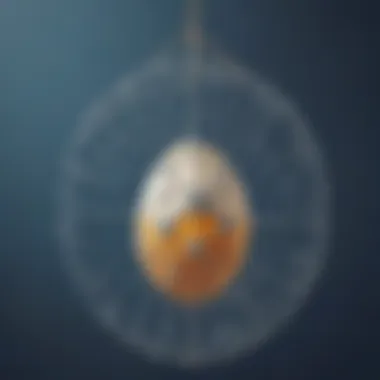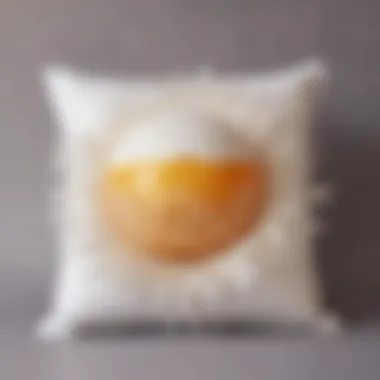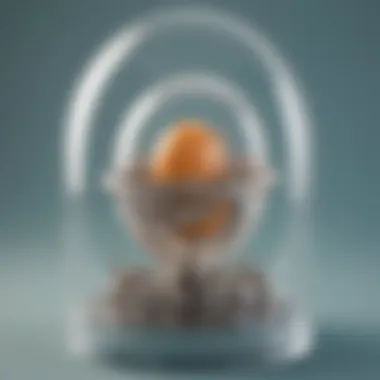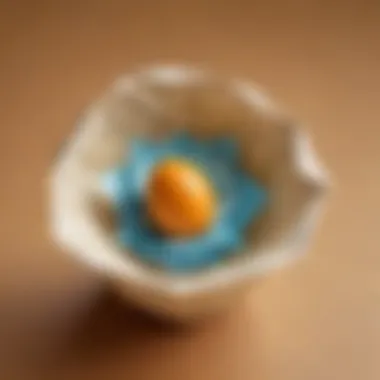Unleashing Creativity: Innovative Ideas for the Egg Drop Experiment


Science Fun Facts
Egg Drop Experiment provides an excellent opportunity to delve into the fascinating world of physics and engineering through hands-on exploration. Did you know that the shape of an egg plays a crucial role in determining its survival when dropped from a height? The unique structure of an egg, with its curved design, helps distribute the force of impact evenly, reducing the chances of breakage.
Quirky Science Stories
In a quirky turn of events, scientists once conducted an experiment where they dropped eggs from varying heights to study the impact forces. Surprisingly, some eggs survived falls that seemed impossible, showcasing the resilience of nature's design. These unexpected outcomes highlight the intricate dynamics at play during an egg drop experiment.
Discover the Wonders of Science
Embark on a journey to explore the wonders of science through the lens of an egg drop experiment. By engaging in this hands-on activity, children aged 6-12 can grasp fundamental physics principles such as gravity, momentum, and impact forces in a practical and engaging manner.
Educational Videos and Animations
Unlock the world of physics with captivating educational videos and animations that visualize the forces at play during an egg drop. Watching simulations of eggs falling from heights and the resulting impacts can enhance children's understanding of scientific concepts in action.
Science Experiment Showcase
Dive into the intriguing science experiment showcase tailored for the egg drop activity. Discover fun and engaging experiments that challenge participants to design protective contraptions using everyday materials. Step-by-step instructions, a detailed materials list, and essential safety tips ensure a smooth and enriching scientific exploration for young minds.
Introduction to Egg Drop Experiment
The egg drop experiment presents a captivating intersection of science and creativity, offering participants a hands-on exploration of physics and engineering concepts. This engaging activity serves as a pivotal opportunity for young minds aged 6-12 to delve into the realms of critical thinking and problem-solving. By immersing themselves in the process of designing protective structures for eggs, children and their guardians embark on a journey of innovation and learning. This section will delve into the foundational elements that underpin the egg drop experiment, shedding light on its significance and the skills it nurtures.
Understanding the Basics of Egg Drop Experiment
Impact of Gravity on Falling Objects
Embarking into the discussion on the impact of gravity enriches our understanding of how objects behave in free fall. Gravity, as a fundamental force, influences the trajectory and velocity of objects, including the fragile eggs at the center of this experiment. Recognizing the role gravity plays in determining the outcome of the egg drop not only enhances the scientific acumen of participants but also challenges them to craft solutions that counteract its effects. While the gravitational pull shapes the experiment's essence, participants will navigate its implications to engineer successful egg protection mechanisms.
Materials Required for Egg Drop Experiment
The choice of materials for the egg drop experiment contributes significantly to its outcomes. Selecting suitable items that offer cushioning, structural support, and shock absorption is paramount in safeguarding the eggs during the test. From everyday objects like cotton balls and plastic bags to specialized components like straws and sponges, each material brings a unique property to the design process. Understanding the characteristics and functionalities of these materials equips participants with the knowledge needed to construct effective egg protection devices.
Importance of Design and Structure in Protecting the Egg
The design and structure of the protective contraption play a pivotal role in determining the experiment's success. By meticulously planning and crafting the protective shell around the egg, participants engage in critical decision-making processes that balance creativity with functionality. An effective design not only shields the egg from impact forces but also showcases the ingenuity and problem-solving skills of the designers. As participants explore diverse design strategies, they sharpen their spatial reasoning and engineering capabilities, preparing them for future challenges in the STEM domain.


Key Objectives of the Experiment
The egg drop experiment encompasses several key objectives that drive its educational value. Participants are encouraged to apply scientific principles, demonstrate innovation, and hone their analytical skills throughout the project. By setting clear goals such as minimizing impact forces, promoting structural integrity, and maximizing egg protection, the experiment fosters a holistic learning experience. These objectives serve as guiding beacons for participants, directing their efforts towards creating effective and inventive solutions to the overarching problem.
Safety Measures and Guidelines
Elevating the importance of safety considerations within the egg drop experiment framework is essential to ensure a secure and productive learning environment for all participants. By outlining stringent safety measures, including roles of adult supervision, proper handling of materials, safe testing environments, and emergency procedures, this section underscores the significance of prioritizing well-being during scientific exploration. Participants and facilitators are urged to adhere to these guidelines meticulously, enabling a seamless and risk-conscious execution of the experiment.
Creative Design Ideas
Creative Design Ideas play a crucial role in the Egg Drop Experiment, offering participants a platform to showcase their innovation and problem-solving skills. In this section, we delve into various elements that elevate the experiment and provide insights into household items and engineering concepts that can enhance the project's outcome. Creative Design Ideas are the backbone of this article, emphasizing the significance of thinking outside the box and experimenting with unconventional materials and concepts.
Utilizing Household Items
Household items are versatile resources that can be utilized creatively to optimize the Egg Drop Experiment. From cushioning with cotton balls to constructing protective shells with straws, household items offer a cost-effective and easily accessible solution to design challenges. Incorporating sponges for absorption introduces a new dimension to the experiment, focusing on minimizing impact forces during the drop.
Cushioning with Cotton Balls
Cushioning with cotton balls provides a soft and impact-absorbing layer that protects the egg from breaking upon impact. The fluffy texture of cotton balls cushions the egg efficiently, reducing the transfer of force during the drop, ensuring the egg's safety.
Creating Parachute with Plastic Bags
Creating a parachute with plastic bags adds an element of air resistance that slows down the descent of the egg, lowering the impact velocity. This technique enhances the egg's chances of surviving the drop by controlling the speed of descent and providing a gentle landing.
Constructing Protective Shell with Straws
Constructing a protective shell with straws creates a lightweight yet sturdy barrier around the egg, shielding it from external forces. Straws offer a structural framework for the shell, adding durability without adding excessive weight to the design.
Incorporating Sponges for Absorption
Incorporating sponges for absorption focuses on minimizing shock and impact forces during the drop. Sponges act as a cushioning material that absorbs kinetic energy, protecting the egg from sudden jolts upon landing. Their ability to compress and expand helps in dissipating energy efficiently.
Innovative Engineering Concepts
Innovative engineering concepts introduce participants to advanced techniques that optimize the egg drop project. Applying aerodynamics principles, implementing shock absorption techniques, exploring tension and support systems, and creating advanced impact dissipation mechanisms elevate the experiment's complexity and educational value.
Applying the Principles of Aerodynamics
Applying the principles of aerodynamics involves designing the project to minimize air resistance and maximize stability during descent. By optimizing the shape and structure of the egg container, participants can improve aerodynamic performance, ensuring a smoother drop trajectory.


Implementing Shock Absorption Techniques
Implementing shock absorption techniques focuses on mitigating impact forces by integrating materials and design elements that absorb and dissipate energy. By carefully selecting shock-absorbing materials and configurations, participants can enhance the protection offered to the egg.
Exploring the Use of Tension and Support Systems
Exploring tension and support systems introduces participants to structural engineering concepts that ensure stability and structural integrity during the drop. Utilizing tension to distribute forces evenly and support systems to reinforce critical points help in enhancing the design's robustness.
Developing Advanced Impact Dissipation Mechanisms
Developing advanced impact dissipation mechanisms involves creating innovative solutions to minimize the effect of impact forces on the egg. By incorporating mechanisms such as springs, dampers, or deceleration systems, participants can enhance the project's ability to withstand drops from varying heights.
Testing and Refinement Phase
For children engaged in the Egg Drop Experiment, the testing and refinement phase plays a pivotal role in advancing their grasp of scientific principles and problem-solving skills. This phase enables young learners to experience the iterative nature of scientific inquiry, fostering a deep understanding of the concepts at play. Through repeated testing and analysis, participants gain valuable insights into the impact of different design elements on the protection of the egg during the drop. The refinement stage not only hones their critical thinking abilities but also encourages creativity as they explore various modifications to enhance their egg-protecting structures.
Trial and Error Approach
Recording and Analyzing Test Results
Emphasizing the importance of meticulous data collection, reporting, and interpretation, the process of recording and analyzing test results is fundamental to the success of the Egg Drop Experiment. By meticulously documenting each trial, young experimenters can identify patterns, draw correlations, and derive informed conclusions. The systematic approach to data analysis enhances their problem-solving skills, enabling them to make data-driven decisions when refining their designs.deisgns The accuracy and thoroughness in recording and analyzing test results elevate the scientific rigor of the experiment, fostering a culture of precision and meticulousness essential for scientific inquiry.
Adjusting Designs Based on Performance
As participants evaluate the performance of their initial designs through test runs, the process of adjusting designs based on performance emerges as a critical step in enhancing the efficacy of their constructions. By carefully observing how different components interact and affect the outcome, young learners can make targeted modifications to address vulnerabilities and optimize their structures for egg protection. The adaptability and willingness to refine designs based on empirical evidence instill a sense of resilience and perseverance, crucial traits in navigating complex problem-solving scenarios.scenarios Adjusting designs based on performance illustrates the practical application of scientific concepts and the value of continuous improvement in engineering projects.
Iterative Process of Improvement
The iterative process of improvement underscores the cyclical nature of scientific exploration, emphasizing that advancements are incremental and often built upon previous iterations. Young participants engage in a cycle of design, testing, evaluation, and modification, steadily refining their prototypes through successive iterations. This approach fosters a growth mindset, encouraging children to view setbacks as opportunities for learning and refinement. The iterative nature of improvement cultivates resilience, adaptability, and a nuanced understanding of the role of failure in the pursuit of innovation - components essential for fostering a lifelong passion for scientific inquiry.
Documenting Learnings for Future Experiments
An integral component of the testing and refinement phase is the practice of documenting learnings for future experiments, encapsulating insights gleaned from each iteration. By maintaining detailed records of design modifications, test results, and observations, participants create a valuable repository of knowledge to inform future endeavors. Documenting learnings not only enhances the reproducibility of the experiment but also encourages reflective practices, prompting children to critically evaluate their progress and identify areas for growth. The documentation of learnings instills a sense of accountability and ownership in young learners, nurturing a scientific mindset centered on continuous learning and improvement.
Presentation and Decusions
The culmination of any project holds immense significance, and the [Presentation and Decisions] aspect within the context of the egg drop experiment is no exception. This section serves as a platform to showcase the hard work, creativity, and problem-solving skills demonstrated throughout the experiment. It is an opportunity for participants, especially children and parents, to highlight their innovative ideas and engineering concepts.
This segment is not merely a conclusion but a reflection of the entire process, showcasing the evolution of designs, the incorporation of feedback, and the learning journey experienced by participants. By presenting the final design, participants can gain a deeper understanding of the principles of physics and engineering in action.


Furthermore, the [Presentation and Decision] phase allows for a formal demonstration of the experiment's outcomes, offering a visual representation of the theoretical concepts applied. It also emphasizes the importance of effective communication skills in narrating the design choices and the thought process behind them.
In essence, the [Presentation and Decusions] section encapsulates the essence of the egg drop experiment, emphasizing creativity, critical thinking, and the practical application of STEM principles in a tangible project.
Showcasing the Final Design
Displaying Innovation and Creativity
Displaying innovation and creativity in the final design of the egg drop experiment is paramount to the success of the project. By incorporating unique and novel ideas, participants can set their designs apart from conventional solutions.
The key characteristic of displaying innovation and creativity lies in thinking outside the box. Participants are encouraged to experiment with unconventional materials, designs, and concepts to showcase their creativity and engineering prowess.
One unique feature of displaying innovation and creativity is the ability to spark curiosity and inspire others. By presenting an innovative solution, participants can inspire peers and mentors to explore new avenues of problem-solving and design thinking.
While displaying innovation and creativity adds a distinct flair to the egg drop experiment, it is essential to balance novelty with practicality. Ensuring that innovative solutions also address the core objectives of the experiment is crucial for a successful showcase.
Explaining the Thought Process Behind Design Choices
Exciting Text
Demonstrating the Egg Drop Test
Exciting Text
Highlighting Lessons Learned
Exciting Text
Reflective Insights
Personal Growth Through Experimentation
Exciting Text
Acquired Skills in Problem Solving
Exciting Text
Encouragement - for Further STEM Exploration
Exciting Text
Celebrating Success and Persistence
Exciting Text







